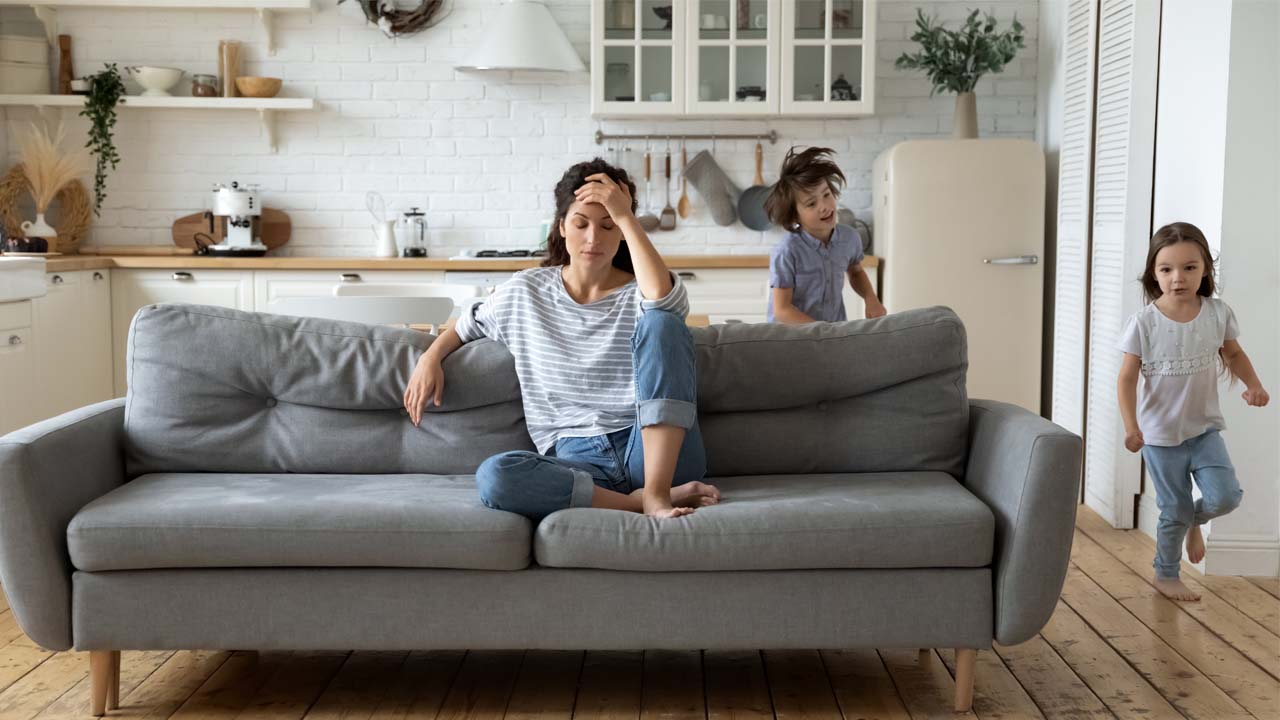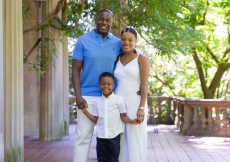When this all started back in March 2020, I, like most people, was terrified—of my husband getting sick, my kids getting sick, my older parents getting sick. I was scared our small business, which services offices, would never recover, which would mean selling our house, finding new jobs, and starting all over again. Even the idea of running out of toilet paper kept me up at night. But I also felt strongly that finding ways to keep our collective chins up would see us through. I wrote about how I was practicing yoga, gratitude and meditation—yes, I was that annoyingly positive woman. But for me, it really was how I was coping. I was enjoying my family being together, leaning into them on the darker days.
Cut to 20 months later and that positive attitude has given way to a feeling of drowning, or at best, just keeping my head above the surface.
It seems I’m surrounded by so many people who have returned to some semblance of normalcy, or at least are no longer operating under the same strain of pandemic life that overshadows my days, but for me, life is just as hard, and in some ways, harder. A year ago, us parents were all on the same sinking ship, navigating homeschooling or caring for younger kids, or both. I was homeschooling my 6-year-old and caring for my 18-month-old at the same time and it was truly brutal, but I had people to commiserate with.
Now, older kids have gone back to school and most of my friends have sent their younger kids back to daycare or have some help at home, like a nanny, a cleaner or at least grandparents coming over to help. And even though my oldest, James, is thankfully back at school, I still have my youngest, Sean, full-time on my own, thanks to circumstances brought on by the pandemic.
Pre-COVID, I ran our small business, GoJava, with my husband. We provide in-office coffee, snack, and beverage services, so needless to say with offices still mostly shut down in Toronto, we are nowhere near the recovery we thought we’d be in by now. My husband is the head of the company so he still gets a paycheque and a place to go where he can have adult conversation and use his brain, but there isn’t enough money to pay me beyond a few hours a week.
So instead, I live in a world where just going pee is a mission now that Sean is so active and follows me everywhere I go. I have to strap him into his high chair, leave him with a snack, and put on The Wiggles to buy myself two minutes of relief, all the while praying that in those two minutes he doesn’t somehow figure out how to unstrap himself and tumble out of his chair, or worse.
Yes, I know this is what it’s like to take care of a toddler, and for some, keeping their young children at home full time at this age is a decision made consciously. But by now I would have chosen to start transitioning back to work part-time, with Sean entering daycare part-time as well, in order to create more balance in our home life.
I had other plans, too. In addition to working with my husband, my freelance writing career was gaining momentum after nearly a decade of pounding that pavement, and I had also developed a successful expressive writing workshop series with a clinical psychologist.
I was excited to get back to growing these writing workshops—it gave me a huge sense of purpose to know that I’d found a way to use my love of writing to help others heal and explore themselves.
But with Sean still at home, my workshops and writing are on hold. Even writing this piece required Herculean efforts, stealing snippets of time, making edits while also making dinner, and ignoring requests for more snacks, just to do this one thing to remind me of my life outside of being a maker of lunches and doer of laundry.
Staying bubbled up at home isn’t just affecting me—it also means Sean, who was 7 months at the start of the pandemic, is now almost two and a half and has had very little exposure to anyone outside of our neighbours and immediate family. Sending him to daycare without my full-time income would have been a huge financial burden over these last months, but I’ve seen the way being home with me for too long—without the benefit of drop-in centres, play dates and mommy and me music classes—has impacted him. While it’s hard to say whether his personality would have developed along this path or not, I’m starting to see traits that I believe have been influenced by his time in isolation, like not caring to interact with kids at the park.
Mothers I speak to who also still have young children at home, either because they don’t want to expose them to the virus, or through financial necessity like me, all say some version of the same thing, which is that we are stuck in a particular purgatory, waiting for life to return to whatever normal means and finally get a break. We are the ones taking care of our kids without the support of childcare or regular help, and we are continuing to shoulder the lion’s share of the parenting burden so that our partners who make more money can work to pay the bills. All in the midst of a pandemic that has lasted longer than any one of us anticipated. The never-ending limbo is starting to wear us down.
Back in the summer, I thought that by September I would be able to start finding my way back to myself. I thought I would have space in the day to breathe, to think, to be creative and productive again, as well as being a devoted mom. Even though my older son is now back at school, meaning I have one less child to care for during the day, I still have a small person with me for most of the time who is loud, who loves the feeling of smashing crackers in his fists to hear how it sounds when they fall on the floor and who has a constant urge to dump the entire toy bin on the floor multiple times a day, just because.
There’s also the ongoing stress of making sure I’m limiting his exposure to the virus, his vulnerability to getting sick being a constant thought in the back of my mind when I weigh whether or not we should go indoors, whether that’s to the grocery store or someone’s house. I would be lying if I said it didn’t factor into my keeping him home from daycare longer, feeling like I could justify delaying his entry into preschool not only because of the cost but also because of the fact that I was scared of him being exposed and falling into the statistics of children who had serious complications.
When I am able to carve out a small window to practice the yoga, gratitude and meditation that helped me in the early, optimistic days of the pandemic, I find glimmers of hope on the horizon. As the vaccine rolls out for 5 to 11-year-olds, and the fact that offices will have to open up eventually, the possibility for my return to a more balanced life becomes tangible. I know I just have to keep holding on until then.
But for Sean, I don’t think we can wait any longer. Conserving money at the expense of his development is not a choice I feel like I can continue to make, but it’s an impossible thing to know the right answer without a crystal ball to tell me when the right time is, and how to weigh all of the considerations, especially with the new Omicron variant thrown into the mix. It’s an ongoing debate in our house between keeping him at home to reduce our financial burden or to take the financial hit of sending him to daycare for the benefit of his wellbeing. As the days go by, with each tantrum he throws out of sheer boredom, with every lonely park visit where it’s just me, him, and a few busy squirrels, it feels like the scale is tipping towards sending him to daycare so that he can begin to experience life with other children, more stimulation, and more fun, trading off one type of stress for another in order to give him what I know deep down he so badly needs.
I know it could be so much worse. We have not contracted COVID-19. We have not lost family members or friends to this virus. My gratitude for what we do have, for what we haven’t lost, has never left me. But it’s not over yet. I am very much still in survival mode, waiting, hopefully soon, to get to the other side.


































